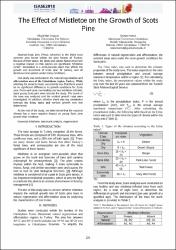The Effect of Mistletoe on the Growth of Scots Pine

View/
Access
Attribution 3.0 United Statesinfo:eu-repo/semantics/openAccesshttp://creativecommons.org/licenses/by/3.0/us/Date
2018Access
Attribution 3.0 United Statesinfo:eu-repo/semantics/openAccesshttp://creativecommons.org/licenses/by/3.0/us/Metadata
Show full item recordCitation
Kapsam:Uluslararası İndeks türü:Tam metin bildiriAbstract
Scots pine (Pinus sylvestris) is the third most common pine found within the pine forests of Turkey. Because of their status, the biotic and abiotic factors that have a negative impact on this species are significant. Mistletoe (order: Santalales) is a semi-parasite plant that affects the growth and increment of Scots pine, fir (Abies), and all deciduous tree species under many conditions. Our study was conducted in the natural regeneration and afforestation area of the Gümüşhane region, Turkey. While selecting the areas to study, our priority was that there would be no significant differences in growth conditions for Scots pine. From each area, two healthy and two mistletoe-infected; eight young Scots pine were selected for study. The trunk of the trees was analyzed and the vertical growth rates were investigated. In addition, whether there was any correlation between the Erinç index and vertical growth rate was determined. At the end of the study, we determined that the regional climate has a more negative impact on young Scots pine growth than mistletoe.
Collections
The following license files are associated with this item:


















